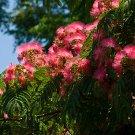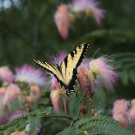Mimosa Trees for Sale
The Mimosa Tree, a member of the Fabaceae family, originated in Asia and was first introduced to the United States in 1745. The mimosa is a small to medium size tree that matures to 20-40 feet tall. Mature trees open to a “V” shape, allowing full sun exposure to the many branches of the white & purple flowering trees. The mimosa tree is a fast grower, with the ability to put on 2 feet or more of growth during a season.
The mimosa tree can acclimate itself to various soil conditions and types. Though they prefer a well drained, moist soil, mimosa trees can grow in poor soil conditions and can withstand periods of drought. These types of mimosa trees prefer full sun without competition from other plants or trees. Mimosas are Winter hardy through Zone 6 and thrive in the high Summer heat of the Southern climates.
Beautiful pink pom pom blossoms make their appearance on the trees May through July. The alternately arranged, compound leaves give the mimosa tree branches a fern or feather like appearance. Foliage of the mimosa are a medium green color that lasts through the fall. The foliage does not change in the fall season. Flowers are formed at the base of the current years twig growth. The bloom is very fragrant and seemingly drips nectar, making them highly attractive to butterflies, honeybees and especially hummingbirds.
Mimosa trees reproduce both vegetatively and by seed. It is best to plant them in an area that does not receive a lot of foot traffic to help with leaf and seed pod litter. Regular raking and removal of this litter will help prevent unwanted mimosa seedlings. A good pruning for these trees is recommended during the dormant season to help their drooping limbs stay strong. The average life span of a mimosa tree is 20 years, which is shorter than many other flowering trees. However, these types of mimosa trees are fairly easy to propagate from seed and fast growers, so growing a replacement tree is right at your fingertips.
Mimosa tree varieties truly offer something for everyone interested in beauty. Native to Asia and Africa, this tree has found a home from Pennsylvania to South Florida, and all the way across the Central United States to California. This deciduous tree is low branching with light gray bark, arching limbs, and fern-like green leaves. The show stealer comes in the summer with the Mimosa's brilliantly colored flowers which consist of many stamens.
In full or partial sun this tree is sure to thrive. It is drought tolerant and prefers well-drained, acidic soil; although it is extremely adaptable to many soil conditions. This tree's fragrant flowers are an instant attraction to butterflies, hummingbirds, and bees who are natural pollinators for the flowers in your bed and the fruit on your trees and vines. Another fine aspect of this tree is that the leaves curl in the night air and unfurl in the morning sun giving this tree the moniker of "Sleeping Tree". As you can see, this tree really does offer something for every planting enthusiast.


